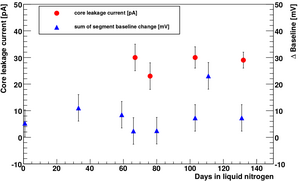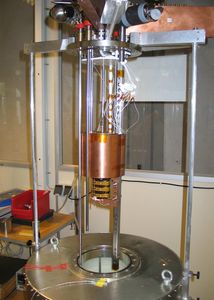The Gerdalinchen II test facility
The GII test facility was designed to operate up to three large segmented germanium detectors submerged in cryo liquids over many months. It was also designed to provide safe cooling and warming procedures to test the resilience of detectors against cooling and warming cycles. The term "safe" refers to the necessity ot avoid water ice to form on the detectors.
The facility is equipped with three external electronics boxes, each one suited to read out up to 20 channels. It also provides the opportunity to mount electronics inside the gasous or the liquid volume of the cryostat. A copper screen provides protection against infrared radiation from the neck of the cryostat. A central rod allows for easy mounting of detectors which can be placed in specially designed holders. Other holders can easily be adapted. It is possible to scan 120 degrees of the mantle of a detector using a special source holder which is part of the facility.

The facility was used to verify that the longterm operation of segmented detectors in cryogenic liquids is feasible. It was proven that the leakage current of the detector was stable over more than 100 days and that the energy resolution of the detector core and all segments did not deteriorate.
The facility was also used for other long-term tests including scans of detectors.
In the future, the facility will be used to test active veto systems using PEN also developed at the MPI.
Key publications
Operation of an 18-fold segmented n-type HPGe detector in liquid nitrogen
J. Instrum. 4 (2009) p11008
Alpha-event and surface characterisation in segmented true-coaxial HPGe detectors
Nucl. Instrum. Meth. A 858 (2017) 80-89
The GALATEA test-facility for high purity germanium detectors
Nucl.Instrum.Meth. A 782 (2015) 56
Measurement of the temperature dependence of pulse lengths in an n-type germanium detector
Eur. Phys. J. Appl. Phys. 56 (2011) 10104
Pulse shape simulation for segmented true-coaxial HPGe detectors
Eur. Phys. J. C 68, 609-618 (2010)
Neutron Interactions as Seen by A Segmented Germanium Detector
Eur. Phys. J. A 36, 139-149 (2008)
Characterization of the first true coaxial 18-fold segmented n-type prototype detector for the GERDA project Nucl.Instrum.Meth. A 577 (2007) 574
Key publications
Operation of an 18-fold segmented n-type HPGe detector in liquid nitrogen
J. Instrum. 4 (2009) p11008
Alpha-event and surface characterisation in segmented true-coaxial HPGe detectors
Nucl. Instrum. Meth. A 858 (2017) 80-89
The GALATEA test-facility for high purity germanium detectors
Nucl.Instrum.Meth. A 782 (2015) 56
Measurement of the temperature dependence of pulse lengths in an n-type germanium detector
Eur. Phys. J. Appl. Phys. 56 (2011) 10104
Pulse shape simulation for segmented true-coaxial HPGe detectors
Eur. Phys. J. C 68, 609-618 (2010)
Neutron Interactions as Seen by A Segmented Germanium Detector
Eur. Phys. J. A 36, 139-149 (2008)
Characterization of the first true coaxial 18-fold segmented n-type prototype detector for the GERDA project Nucl.Instrum.Meth. A 577 (2007) 574
